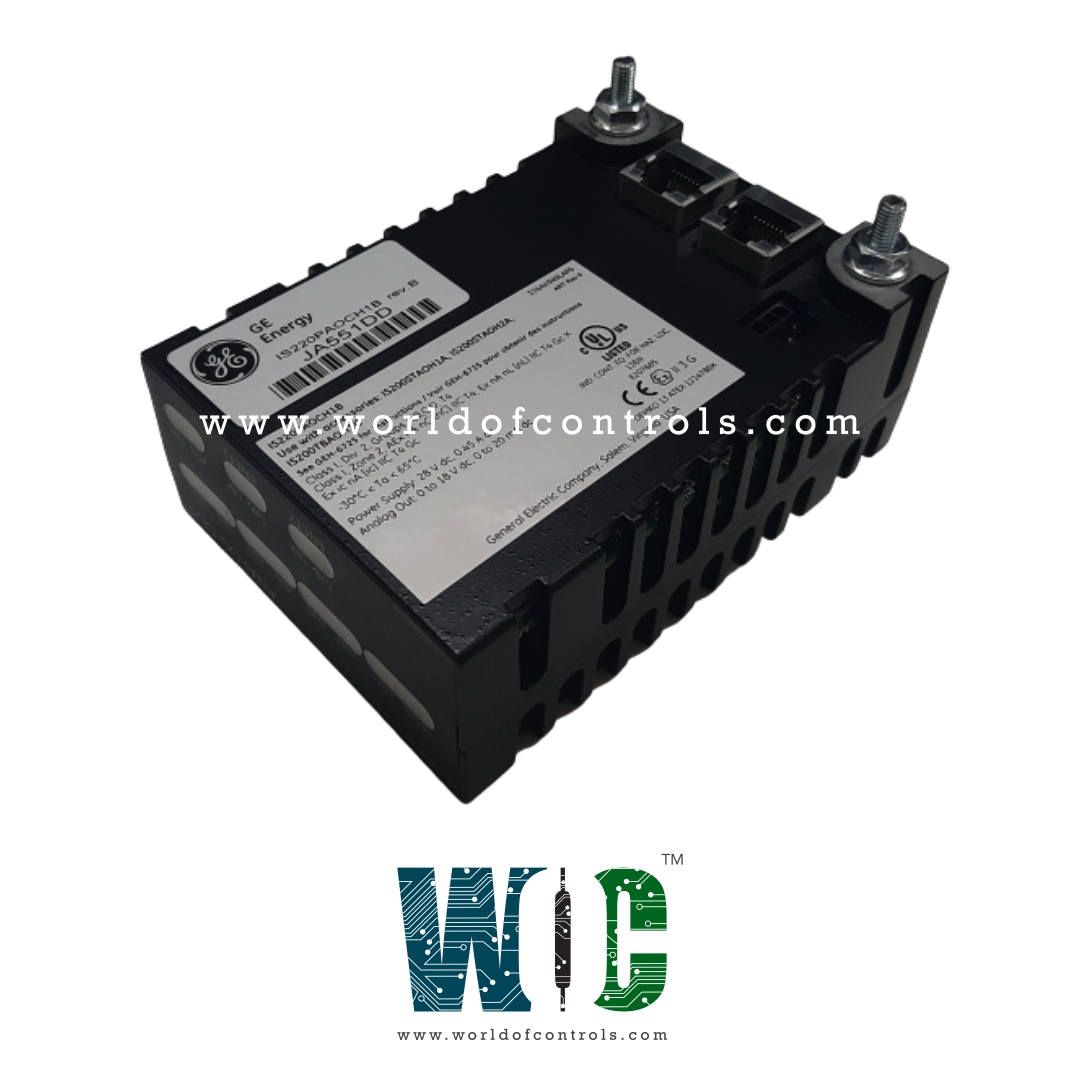
World Of Controls understands the criticality of your requirement and works towards reducing the lead time as much as possible.
IS220PAOCH1B, REV B - Analog Output I/O Module is available in stock which ships the same day.
IS220PAOCH1B, REV B - Analog Output I/O Module comes in UNUSED as well as REBUILT condition.
To avail our best deals for IS220PAOCH1B, REV B - Analog Output I/O Module, contact us and we will get back to you within 24 hours.
SPECIFICATIONS:
Part Number: IS220PAOCH1B, REV B
Manufacturer: General Electric
Series: Mark VIe
Product Type: Analog Output Module
Number of channels: Eight current output channels
Analog Outputs: 0-20 mA, up to 900 Ohms
Accuracy: ±0.5% over -30º to 65ºC
Size: 8.26 cm high x 4.19 cm wide x 12.1 cm
Availability: In Stock
Country of Origin: USA
Operating Temperature: -30 to 65°C
Size: 8.26 cm high x 4.19 cm wide
Availability: In Stock
Country of Origin: USA
Manual: GEH-6721D
FUNCTIONAL DESCRIPTION:
IS220PAOCH1B, REV B is an Analog Output I/O Module manufactured and designed by General Electric as part of the Mark VIe Series used in GE Distributed Control Systems. The PAOC (Analog Output Pack) serves as the electrical interface between one or two I/O Ethernet networks and an analog output terminal board. It includes a common processor board used across all Mark VIe distributed I/O packs, along with a dedicated analog output acquisition board pair. This pack supports up to eight simplex 0–20 mA current loop outputs and features an analog-to-digital converter to provide current feedback for each output channel. Inputs are received via dual RJ45 Ethernet connectors and a three-pin power input, while outputs are delivered through a DC-37 pin connector that directly mates with the corresponding terminal board. The unit also features indicator LEDs for visual diagnostics and supports local diagnostic communication through an infrared port.
COMPATIBILITY:
PAOCH1A is compatible with the analog output terminal board TBAOH1C, and the STAO board, but not the DIN-rail mounted DTAO board. The following table gives details of the compatibility: Control mode refers to the number of I/O packs used in a signal path:
ANALOG OUTPUT HARDWARE:
The PAOC features eight simplex 0-20 mA analog outputs with 18 V compliance. Each output is controlled by a 16-bit digital-to-analog converter (DAC) that drives an external transistor amplifier and regulates the output current. A built-in temperature sensor monitors the internal temperature of the board, alerting the control system if it becomes too high. Each analog output includes a mechanical normally open relay that enables or disables the output. When the relay is disabled, the output is routed through the relay, opening the circuit between the customer load and the PAOC’s analog output. The status of the relay is indicated by an LED, using the second normally open contact of the relay.
CURRENT FEEDBACK HARDWARE:
The PAOC provides current feedback monitoring for each of its eight simplex 0-20 mA analog outputs. The output current is measured using a 16-bit analog-to-digital converter and a 50-ohm resistor on the terminal board. The PAOC I/O pack, featuring eight linear, high-compliance analog outputs, has certain operational limitations based on the ambient environment. For PAOCH1B packs, the operating temperature range is -40 to 70°C (-40 to 158°F) when measured from the outside of the pack. However, due to its dense triple board layout, the maximum ambient temperature must be reduced depending on the specific application. The minimum output impedance is defined by the minimum series equivalent resistance of the customer load, as indicated by the terminal board screws across the 0–20 mA output range.
WOC has the largest stock of OEM Replacement Parts for GE Distributed Control Systems. We can also repair your faulty boards and supply unused and rebuilt boards backed up with a warranty. Our team of experts is available around the clock to support your OEM needs. Our team of experts at WOC is happy to assist you with any of your automation requirements. For pricing and availability on parts and repairs, kindly contact our team by phone or email.
What is the difference between Analog Output and Digital Output modules?
Analog Output modules provide variable signals (voltage/current), whereas Digital Output modules provide binary ON/OFF signals.
What is an Analog Output I/O Module?
An Analog Output I/O Module is a device used in automation and control systems to convert digital signals from a controller (PLC/DCS) into continuous analog signals (such as 4-20 mA or 0-10 V) to control actuators like valves, motors, or drives.
How many output channels are usually available on analog output modules?
The number of output channels on an analog output module varies depending on the manufacturer and model. Standard modules are commonly available with 2, 4, 8, or 16 output channels.